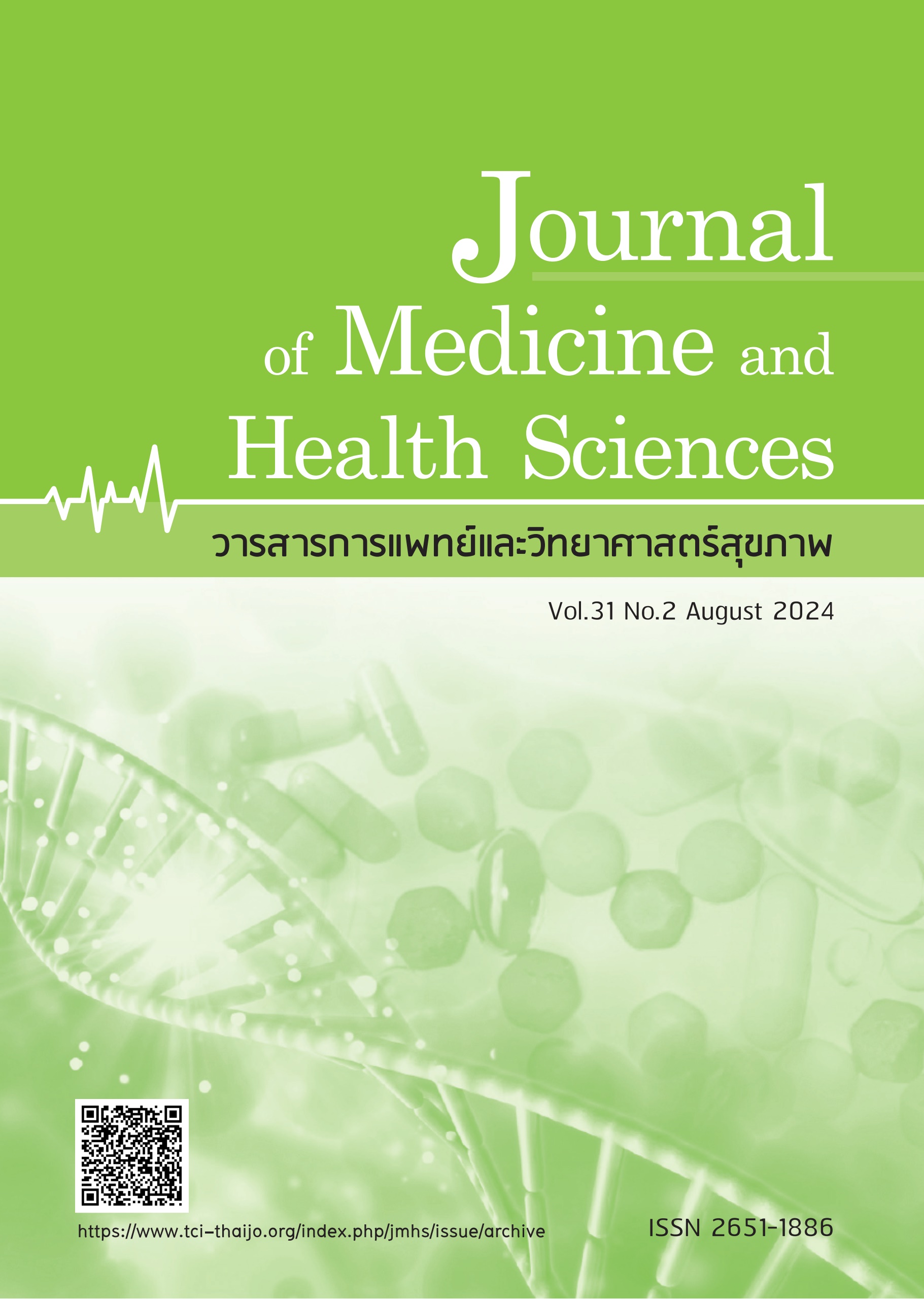บทความวิจัยเรื่อง ฤทธิ์ต้านอนุมูลอิสระและฤทธิ์ทางชีวภาพของสารสกัดผลส้านหิ่ง (Dillenia parviflora Griff.)
คำสำคัญ:
ส้านหิ่ง, ต้านอนุมูลอิสระ, อีลาสเทส, ไทโรซิเนส, ไฮยาลูโรนิกบทคัดย่อ
งานวิจัยนี้มีวัตถุประสงค์เพื่อทดสอบฤทธิ์ต้านอนุมูลอิสระและฤทธิ์ทางชีวภาพของสารสกัดผลส้านหิ่ง Dillenia parviflora Griff. (Dp) โดยการตรวจวิเคราะห์ต่างๆ ดังนี้ การหาปริมาณฟีนอลิกทั้งหมดของสารสกัด ฤทธิ์ในการต้านอนุมูลอิสระด้วยวิธี DPPH radical scavenging Assay ฤทธิ์ยับยั้งเอนไซม์อีลาสเทส, เอนไซม์ไทโรซิเนสและเอนไซม์ไฮยาลูโรนิเดส ฤทธิ์ยับยั้งการผลิตไนตริกออกไซด์ในเซลล์เพาะเลี้ยงแมโครฟาจ (RAW 264.7) ที่กระตุ้นด้วยไลโปโพลีแซ็กคาไรด์ (LPS) ฤทธิ์ยับยั้งเอนไซม์อีลาสเทส, เอนไซม์ไทโรซิเนส, เอมไซม์ไฮยาลูโรนิเดส และการทดสอบประสิทธิภาพของการสมานแผลในเซลล์ผิวหนังของมนุษย์ (HaCaT cell) ผลการวิจัยพบว่า ปริมาณเฉลี่ยของปริมาณฟีนอลิกทั้งหมดในตัวอย่าง Dp มีค่าเท่ากับ 28.14±0.97 มิลลิกรัมเทียบเท่ากรดแกลลิกต่อกรัมของตัวอย่าง (mg GAE/g) มีฤทธิ์ต้านอนุมูลอิสระน้อยกว่าวิตามินซี อย่างมีนัยสำคัญทางสถิติที่ระดับ 0.05 (p=0.019) ความเข้มข้นของ Dp ที่ 1 มก./มล. มีฤทธิ์ต้านการอักเสบในเซลล์เพาะเลี้ยงแมโครฟาจ (RAW 264.7) น้อยกว่ายาต้านการอักเสบไตรแอมซิโนโลนอย่างมีนัยสำคัญทางสถิติที่ระดับ 0.05 (p=0.003) มีฤทธิ์ยับยั้งเอนไซม์ไทโรซิเนส IC50 >1000 (mg/ml) น้อยกว่าวิตามินซี มีฤทธิ์ยับยั้งเอนไซม์ elastase น้อยกว่า EGCG อย่างมีนัยสำคัญทางสถิติที่ระดับ 0.05 (p=0.016) ไม่มีฤทธิ์ยับยั้งเอนไซม์ไฮยาลูโรนิเดส ความเข้มข้นของ Dp ที่ 1 มก./มล. สามารถกระตุ้นให้เซลล์ผิวหนังของมนุษย์เคลื่อนเข้าหากัน เร็วกว่ากลุ่มควบคุม แต่ช้ากว่าวิตามินซี 1 มก./มล. (p=0.49) อย่างมีนัยสำคัญทางสถิติที่ระดับ 0.05 งานที่จะทำต่อในอนาคตควรศึกษาสาระสำคัญในการออกฤทธิ์ การศึกษาทางคลินิก เพื่อให้เกิดประโยชน์ในการนำไปประยุกต์ใช้เป็นนวัตกรรมจากสมุนไพร
References
Sabandar CW, Jalil J, Ahmat N, et al. Medicinal uses, chemistry and pharmacology of Dillenia species (Dilleniaceae). Phytochemistry 2017;134:6-25. doi: 10.1016/j.phytochem.2016.11.010
Lima, C.C., Lemos, R.P., Conserva, L.M. Dilleniaceae family: an overview of its ethnomedicinal uses, 3 biological and phytochemical profile. J Pharmacogn Phytochem 2014;3:181-204.
Saiful Yazan L, Armania N. Dillenia species: A review of the traditional uses, active constituents and pharmacological properties from pre-clinical studies. Pharm Biol 2014;52:890-7. doi: 10.3109/13880209.2013.872672
Goh, M.P., Ahmad, N., Yasin, H.M, et al. Antioxidant, antibacterial and cytotoxic activity of the Dillenia suffruticosa Leaves against the Lung (A549) and Cervical (CaSki) Cancer Cell Lines. The Natural Products Journal 2021;(11).DOI:10.2174/2210315511666210204120431
Yakop, F., Sheikh Abdul Hamid, M.H., Ahmad, N, et al. Phytochemical screening, antioxidant and antibacterial activities of extracts and fractions of Dillenia suffruticosa leaves. Malaysian Applied Biology 2020;https://doi.org/10.55230/mabjournal.v49i1.1663
Sabandar, C.W., Jalil, J., Ahmat, N, et al. Antioxidant activity and inhibition of xanthine oxidase of songi bark (Dillenia serrata Thunb.). Jurnal Farmasi Galenika (Galenika Journal of Pharmacy) 2020;https://doi.org/10.22487/j24428744.2020.v6.i1.15008
Biju J., Sulaiman C.T., Satheesh G, et al. Total phenolic and flavonoids in selected medical plants from kerala. Int J Pharm Pharm Sci 2014;6:406-8.
Mongkolsilp S., Pongbupakit I., Sae-Lee N, et al. Radical scavenging activity and total phenolic content of medicinal plants used in primary health care. SWU J Pharm Sci 2004;9:32-5.
Manosroi A, Ruksiriwanich W, Abe M, et al. Biological activities of the rice bran extract and physical characteristics of its entrapment in niosomes by supercritical carbon dioxide fluid. J Supercrit Fluids 2010;54:137-44.
Manosroi, A., Boonpisuttinant, K., Winitchai, S, et al. Free radical scavenging and tyrosinase inhibition activity of physic nut (Jatropha curcas Linn.) seed oil entrapped in niosomes. Current Nanoscience 2011;7:825-9.
Chang, T.S. An updated review of tyrosinase inhibitors. Int J Mol Sci 2009;10:2440-75.
Lee S-H, Sanchetis., Sancheti S, et al. Potent antielastase and antityrosinase activities of Astilbe chinensis. Am J Pharmacol Toxicol 2009;4:127-9.
Kim S.J., Sancheti S.A., Sacncheti S, et al. Effect of 1,2,3,4,6-penta-o-galloyl--d-glucose on elastase and hyaluronidase activities and its type II collagen expression. Acta Pol Pharm 2010;67:145-50.
Manosroi A, Kumguan K, Chankhampan C, et al. Nanoscale gelatinase A (MMP-2) inhibition on human skin fibroblasts of Longkong (Lansium domesticum Correa) leaf extracts for anti-aging. J Nanosci Nanotechnol 2012;12:7187-97.
ISO 10993-5: 2009 Biological Evaluation of Medical Devices. Part 5: Tests for In vitro cytotoxicity. International Organization for Standardization; Geneva, Switzerland: 2009.
Sutthiwanjampa C. and Kim S.M. Production and characterization of hyaluronidase and elastase inhibitory protein hydrolysate from venus clam. Nat Prod Res 2015;29:1614–23
Insaf, A., Parveen, R., Gautam, G, et al. A comprehensive study to explore tyrosinase inhibitory medicinal plants and respective phytochemicals for hyperpigmentation; molecular approach and future perspectives. Curr Pharm Biotechnol 2023;24:780-813.
Torres-Rodríguez M.T., García-Chávez E., Berhow M. Anti-inflammatory and anti-oxidant effect of calea urticifolia lyophilized aqueous extract on lipopolysaccharide-stimulated raw 264.7 macrophages. J Ethnopharmacol 2016;188:266-74.
Muhammad, AA., Pauzi, NAS., Arulselvan, P. In vitro wound healing potential and identification of bioactive compounds from Moringa oleifera Lam. Biomed Res Int 2013;2013:974580. doi: 10.1155/2013/974580
Vichai, V., Kirtikara, K. Sulforhodamine B colorimetric assay for cytotoxicity screening. Nat Protoc 2006;1(3):1112-6. doi: 10.1038/nprot.2006.179.
Downloads
เผยแพร่แล้ว
How to Cite
ฉบับ
บท
License
Copyright (c) 2024 วารสารการแพทย์และวิทยาศาสตร์สุขภาพ

This work is licensed under a Creative Commons Attribution-NonCommercial-NoDerivatives 4.0 International License.





